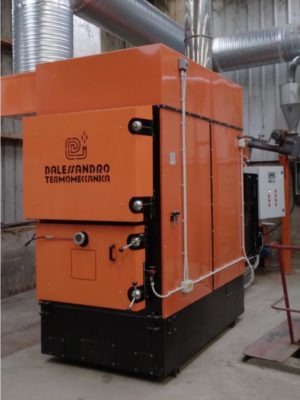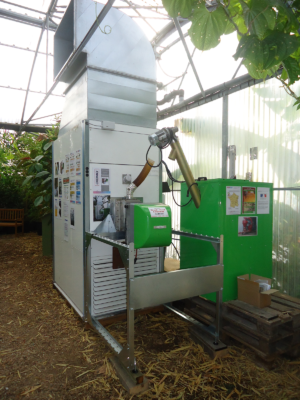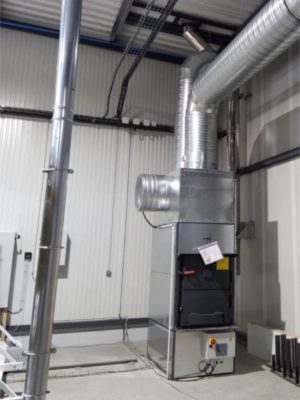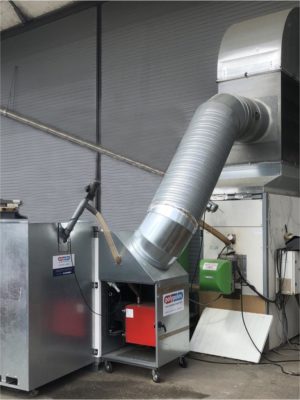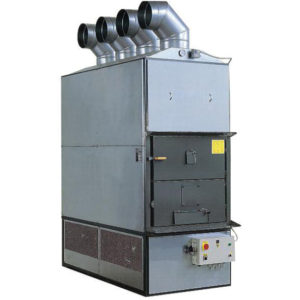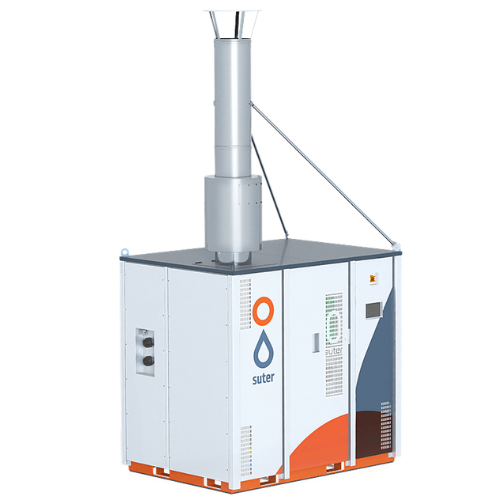All about biomass heating
Biomass heating is a system that produces heat from organic matter such as wood or biological waste. This heating method is based on the use ofrenewable energies and requires the use ofspecific equipment. The advantages of biomass heating are numerous, particularly in terms of energy efficiency, thermal comfort and respect for the environment. If you’d like to find out more about this heating method, we invite you to read this article, which will give you all the information you need.
Biomass heating equipment
To install a biomass heating system, you need to know about all the systems on the market, so you can make your choice.
-
The biomass boiler
The biomass boiler is a heating solution that produceshot water from renewable sources such as wood or biological waste. It can be used to heat homes, business premises or industrial buildings. The boiler works by burning the chosen biomass to produce heat, which is then transmitted to a closed water circuit that circulates through the heating system. The biomass used to fuel the boiler can take a variety of forms: wood logs, wood chips, pellets, olive stones or fruit shells. The choice of biomass will depend on local availability, cost and the energy performance of the equipment used to transform it into fuel. By using a biomass boiler, users can benefit from an economical and ecological heating system, reducing their impact on the environment while saving money on their heating bill. What’s more, biomass boilers may be eligible for various financial and tax incentives to encourage the use ofrenewable energy sources.
-
Pellet stoves
Pellet stoves are becoming increasingly popular as heating equipment. They are often preferred to traditional fireplaces or fireplaces with inserts because of their greater energy efficiency. Pellet stoves have energy efficiencies ranging from 75% to 85%, which means they are highly efficient at converting fuel into heat. What’s more, pellet stoves have an extended autonomy of up to 72 hours, making them very practical for busy homeowners or those who wish to avoid having to refuel their appliance frequently. Pellet stoves are particularly well suited to private homes and small workshops, thanks to their size and portability. They run on wood pellets, which are automatically fed into the combustion chamber by a screw feeder. Wood pellets are considered a sustainable and renewable fuel source, as they are made from recycled sawdust and wood waste. Pellet stoves are also equipped with a ventilation system that ensures even heat distribution throughout the room. This means you can expect a constant, comfortable temperature throughout the room, without having to worry about cold or hot zones. Finally, pellet stoves are easy to maintain and clean, making them very practical for busy homeowners.
-
Biomass furnace
The biomass furnace is a heating appliance designed primarily for industries, local authorities and large surfaces, where it is necessary to heat large areas. It can be fed manually via a manual loading hatch, or it can be equipped with a specific burner for feeding pellets. Before choosing a biomass furnace, it’s important to carry out a personalized study to determine the model best suited to your needs. This study will take into account criteria such as the surface area to be heated, the desired autonomy, the conditions of use, and so on. What’s more, it’s essential to calculate the investment required in relation to the expected return on investment. The installation of a biomass furnace can represent a significant initial cost, but can prove to be a profitable choice in the long term, thanks to the energy savings achieved. All in all, the biomass furnace is a heating system ideally suited to the needs of industry and large-scale facilities, but a personalized study is required to select the model best suited to your needs, and to calculate the return on investment.
 The advantages of biomass heating
The advantages of biomass heating
-
The ecological aspect
Biomass heating offers a number of advantages, not least its ecological credentials. Biomass boilers run on fuels from renewable sources such as wood, wood pellets, olive stones or fruit husks. This energy choice helps to reduce CO2 emissions and thus combat the greenhouse effect. According to the figures, wood produces just 35 kg of CO2 per MWh, while fuel oil produces 480 kg, gas 220 kg and electricity 180 kg. These differences in CO2 emission rates are therefore highly significant. What’s more, biomass boilers are highly energy-efficient and can be a cost-effective alternative to oil or gas heating. Biomass fuel prices can be more stable than those of fossil fuels, offering greater predictability in heating costs. Finally, the use of biomass also reduces dependence on imported fossil fuels, contributing to local energy autonomy.
-
Economic character
Biomass heating also offers considerable economic advantages. Wood is the cheapest fuel on the market, although prices can rise when demand is high. What’s more, biomass heating equipment is highly efficient, up to 95% depending on the boiler model used. This means you can save on your heating costs while benefiting from a renewable energy source. What’s more, it’s possible to use different forms of biomass, such as wood pellets, which are equally economical and efficient in terms of energy performance.
-
Excellent thermal comfort
Biomass heating also offers excellent thermal comfort. Thanks to its high efficiency, it optimizes the temperature of the home by combining central heating circuits. As a result, residents benefit from even, high-performance heating, for optimum thermal comfort.
 The disadvantages of biomass heating
The disadvantages of biomass heating
Biomass heating has a few disadvantages that need to be taken into account before choosing to install such a system in your home. Firstly, in France, there is a shortage of pellets, which can be a problem if this is the only fuel your biomass heater can use. This can lead to supply difficulties and price rises. However, it is possible to turn to other types of fuel such as kernels or nuts if your equipment is compatible. Biomass heating equipment can be cumbersome due to its large volume. It is therefore essential to have sufficient space to install them, as well as for the watertight silo that will store the wood pellets. However, these space constraints can be anticipated in advance when designing your installation project. Finally, it’s worth noting that the cost of a biomass boiler is higher than that of a conventional boiler. For the same output, a biomass boiler can be 2 to 2.5 times more expensive. However, this can be quickly amortized compared with the cost of fossil fuels, thanks in particular to the financial assistance and energy savings that this type of heating can deliver. So it’s important to weigh up all the advantages and disadvantages before making your choice.
Prices and installation of biomass heating equipment
The purchase price of biomass heating equipment ranges from €3,000 to €20,000. To this must be added the cost of installation. This ranges from €500 for manual-feed systems to €3,500 for automatic-feed systems. Then there’s the mandatory annual maintenance. Biomass heating equipment is also eligible for certain grants. You can apply for them to finance part of your biomass heating or boiler. These include the Anah subsidy and the prime énergie energy allowance. You can also apply for reduced VAT, Ma primRénov’ assistance and the eco-PTZ to finance your equipment.
Contact us
For technical information, questions, sizing or a quotation, as a biomass heating specialist, you can count on our technical department to provide you with reliable, cost-effective solutions.
How to choose your heating fuel
- Wood logs are the least expensive fuel, but their output is lower than that of other fuels (pellets, cores, etc.).
Also, this biomass fuel cannot be fed automatically, and must be stored in a dry place. - Wood chips are produced by shredding wood from sawmills or furniture manufacturers,
- Pellets and chips are sold in bags or in bulk. The yield is much higher
- Olive pits (recommended by Polypoles) are the least moisture-sensitive fuel that can be stored in a silo and fed automatically.
How to feed your biomass heater or boiler
You have two options when it comes to managing your heater’s power supply. You can opt for either manual or automatic feeding. With the latter, the fuel is fed to the heater via an auger. A program is set up to allow you to choose the temperature and heating times.

